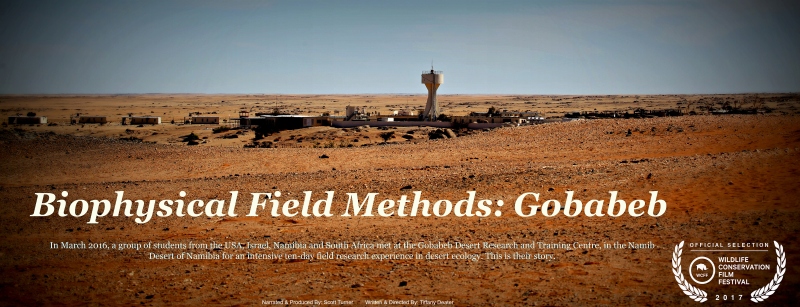The White-Throated Sparrow Project, 2018

Life of the Sengi, 2017

Life of the Sengi pieces together images of the savanna community, highlighting on the everyday existence of the Sengi themselves. I understand and acknowledge the limitations of trying to create objective video work. The framing and camera angles are subjective decisions made by the camera operator, as is the subject matter itself. Footage is edited in a nonlinear timeline; the images are moved around and do not occur in the original sequence of events.
Despite these subjective boundaries Life of the Sengi manages to produce a close to authentic look into animal existence and interaction. It avoids using the cinematic conventions of modern wildlife films and creates a more lifelike video experience with the Sengi.
The Nuptial Gift, 2016

As the cold Namibian night gives way to dawn the air is filled with the rhythmic buzzing as the armoured crickets begin their morning song. Wide bodied and flightless they climb the high savanna grasses to warm themselves in the hot sun. With long serious faces and lightly waving antenna they make their way through the thorny vegetation in search of a mate. Unlike most species the male is the picky one. Much more energy is required by the male for mating and it takes him a while to recover before he can mate again. But once he has chosen a female the mating ritual begins. Their courtship is relatively long for insects starting at early sunset and lasting until sunrise. He leaves his mate with a “nuptial gift” a deposited glob of protein rich food. This gift of food increases the females’ chance of survival and also acts as a mating plug – she cannot mate again until the gift has been eaten. When she is ready to lay her eggs the female cricket digs a hole in the sand with her abdomen. After laying her eggs she carefully covers the hole and once again returns to the savanna grasses.
Biophysical Field Methods Gobabeb, 2016
In March 2016, a group of students from the USA, Israel, Namibia and South Africa met at the Gobabeb Desert Research and Training Centre, in the Namib Desert of Namibia for an intensive ten-day field research experience in desert ecology. They came to Gobabeb as part of a hybrid online/field course called Biophysical Field Methods, taught by Profs Scott Turner (SUNY ESF), Berry Pinshow (Ben-Gurion University) and Dr Eugene Marais, National Museum of Namibia. This is the story of that group. Produced by Tiffany Deater.
Biophysical Field Methods Online Course, 2015
Biophysical field methods online offers a practical approach to biophysical ecology, which applies physical concepts, principles and techniques to the interpretation of animal-environment interactions. These include how physical laws, such as the laws of thermodynamics, affect the abundance and distribution of animals and plants, the nature of microclimate, the ecological niche, and the integration of physiology and evolutionary ecology. Biophysical Field Methods Online
Ducks, Geese, and Swans of North America, 2015
Ducks, Geese, and Swans of North America has been hailed as a classic since the first edition was published in 1942. A must-have for professional biologists, birders, waterfowl hunters, decoy collectors, and wildlife managers, this fully revised and updated edition provides definitive information on the continent’s forty-six species. Maps of both winter and breeding ranges are presented with stunning images by top waterfowl photographers and the acclaimed original artwork of Robert W. (Bob) Hines.
Guy Baldassarre
A Wildlife Management Institute Book
Current Biology, Jan. 21, 2015 (Vol. 26, Issue 3)
Morphs of the white-throated sparrow are determined by large alternative supergenes located on an inversion of chromosome 2. Using over two decades of field data, Tuttle et al. document near-perfect disassortative mating and fitness consequences for those birds that pair assortatively. They then used de novo whole-genome sequencing coupled with population- and phylo-genomic data to show that white and tan morphs are highly divergent at over 1,000 genes, that both supergenes originated prior to the split of the white-throated sparrow from its sister species, and that the white morph supergene was introduced into the lineage through past hybridization/introgression and is degrading over time. The results show how supergenes can arise and become polymorphic in a single species and how, despite their apparent stability in the short term, they are likely to be unstable over long evolutionary time periods.
Elaina M. Tuttle, Alan O. Bergland, Marisa L. Korody, Michael S. Brewer, Daniel J. Newhouse, Patrick Minx, Maria Stager, Adam Betuel, Zachary A. Cheviron, Wesley C. Warren, Rusty A. Gonser, and Christopher N. Balakrishnan (2016). Divergence and Functional Degradation of a Sex Chromosome-like Supergene. Curr. Biol. 26.
Check out the paper at http://www.cell.com/current-biology/a….










